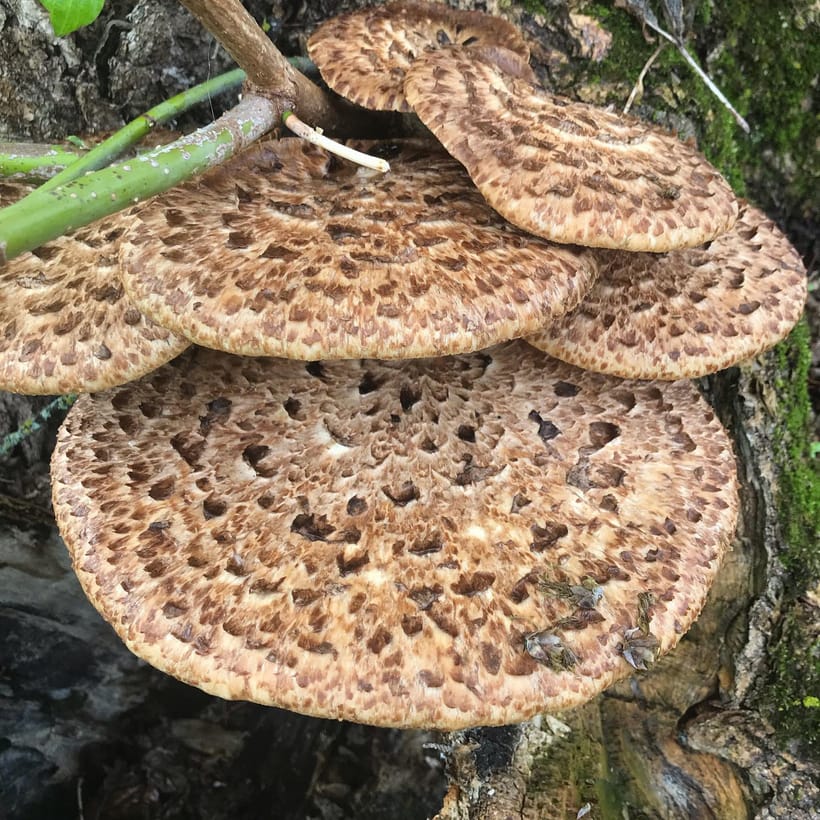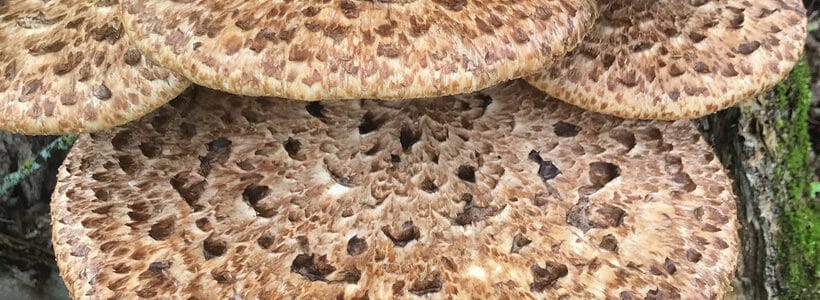Pheasant back mushroom or dryad’s saddle mushroom ( Cerioporus squamosus, aka Polyporus squamosus ).

From Wikipedia: The name “dryad’s saddle” refers to creatures in Greek mythology called dryads who could conceivably fit and ride on this mushroom, whereas the pheasant’s back analogy derives from the pattern of colours on the bracket matching that of a pheasant’s back.
Dryad’s Saddle are often described as having a melon-like smell, which I would agree with. Fresh smelling. They are wonderfully dynamic in their cooked flavour, and I love their texture. When preserved, they take on a rubbery type texture, so keeps well for a long time without degrading in quality. And while rubbery may not be the most appealing sounding texture, when you eat it, it is tender and not at all rubbery.

They usually start to show up at our place in June, mostly on dead or dying elms and Manitoba Maples. Sometimes finding them can be it’s own adventure, as they seem to like growing near the base of the tree, or inside hollow areas. The good news is that once you find a spot where they grow, you’ll see them everywhere, and know where to look. They’ll also appear for years in the same place, so you’ll build on your crop as the years go and you figure out how you like to eat them.
Many people seem to dismiss this mushroom as not being good to eat, but ultimately like a lot of wild foods, requires some creativity and experimentation to see what might work to bring out their unique qualities.

This bracket fungi is a recent one that we’ve branched out on eating more of. It’s excellent if you saute it up in thin slices in butter with garlic, but you have to catch it at just the right time. I have found it a very narrow window of when they are edible this way, as they have a cute little wormy that like to live in the undersides and takes over quickly. You can always cut or scrape off the porous underside layer if the wee ones are present, that’s where they like to hang out the most.
After some investigation, I found a number of recipes and ways that I could preserve them when they’re perfect, and when they’re not.

None of these are my recipes that I created and while I made some changes (mostly using herbs that I had on hand when I may not have had what was suggested).
The first one I tried was making the dryad’s saddle shoyu from the Noma cookbook 3 years ago. A shoyu is a fermented soy sauce, and this recipe required rice inoculated with koji rice, which you can buy from asian grocery stores pre-made.
Here’s Forager Chef’s version with some great modifications:
https://foragerchef.com/pheasant-back-fermented-soy-sauce/
This condiment is tasty, and continues to mature and change flavours. I have used it mostly as a marinade for meats, or added into soups or sauces to bring a hearty umami flavour, especially to vegan dishes.
The next year I came across many recipe ideas from Forager Chef. In generally, his recipes are well tested, well written and explained. I highly recommend his work, and his book just came out! Highly recommend.
Here’s the ones I made, along with some of his info on this beauty:
Pickled Dryad saddle Mushrooms
I love these pickled mushrooms!! I made a bunch of jars 2 years ago and they’re still great texture. I love adding them on top of soups, salads or in sushi. Very versatile and great flavour.
This is also a winner. It’s so good on a veggie or meat burger, on top of steamed veggies.. Yum.
Did you know that ketchup used to refer to many other condiments than tomato ketchup? One of the oldest european ketchup recipes is made with mushrooms. This recipe is a great use for the ends that are to tough, and you add salt until you have enough bulk to make the recipe. So delicious. I have used this tons to add complexity to many things when you don’t have time for it. Brings a richness of flavour to soups, marinades, anything that evokes a long simmering soup.
This recipe for mushroom ketchup I ended up using way more as a mariande mostly, and is much more accessible in terms of not needing any special ingredients, which many of the recipes in the Noma cookbook require (where the shoyu recipe came from). If you already have koji rice on hand, or are feeling adventurous, the shoe is a fun condiment to make and will last you years. The flavours will continue to mature and change as time goes on, as it’s a living food.
For this recipe, you can use older mushrooms, they still make great stock. I just cut them up and simmer for a couple of hours and then drain, sometimes just having it as is with noodles and veggies. Experiment with adding in garlic, onions, other veggies… it’s a dynamic and tasty start to soups.
As with many wild foods, you may be concerned about the little bugs. These ones don’t seem to crawl out if you leave them, like morels. They like the spongey layer, so you can always scrape or cut this part off.
This year I’m trying fermenting these ones, as Pascal Baudar does in his book, ‘Wildcrafted Fermentation’.
Here’s the recipe and info he shared on his instagram page that he made with oyster mushrooms, but I bet would work just as well with the dryad’s saddle.
“The end product will be transformed in many ways, some will be dehydrated to make a sour/tangy/spicy jerky or mixed in soups. Part of the content will be turned into savory paste and the smaller mushrooms will be served mixed with homemade wild mustard and pickled seeds so it has a bit of vinegar flavors. I’ll also make some powder after dehydration to make instant “sour” soups with dried seaweed, acorn miso and so on.
Super easy to do. The larger mushrooms are cut in layers and the smaller ones are left as is. Steamed for 15 minutes, cooled down then ready to ferment.
For this jar I had 1 pound and 4 oz (567 g) of steamed mushrooms. For the fermentation I used:
A bit more than 2 teaspoons of salt (13 g)
2 minced garlic cloves
2 teaspoons of honey
1/2 teaspoon smoked Jalapeno powder
3 tablespoons active sauerkraut juice (as starter) – basically the brine of a young active ferment (3-4 days old)
2 teaspoons wild herbs mix (You can use Italian herbs or Herbes de Provence).
Add around 1/3 cup of water
Place everything in a quart jar and close the lid. I monitor the fermentation, shake the jar 2 or 3 times a day and burp as necessary. I ferment it at room temperature for 10 days then place in the fridge where it will keep for months.
I’m also thinking of a ceviche type dish for some of the shrooms with lime juice, spices, fresh peppers.
So many possibilities and such a neat way to preserve the winter harvest. So far fermentation as worked with oyster mushrooms, baby cremini and button, shiitake and beech mushrooms. I so wish I could find some matsutake to try!”
Would love to hear what you try and how you use it!


